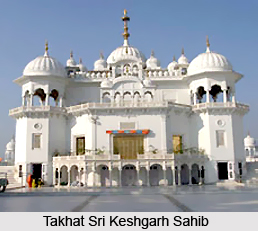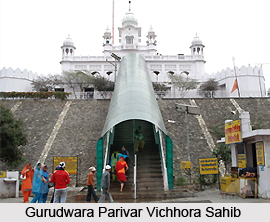 Pilgrimage tourism in Rupnagar District means visits to several holy sites that also have deep historical association. The district has a glorious and religiously significant past that are reflected through its several pilgrimage sites. The various fairs and festivals celebrated here enhance the charm of pilgrimage tourism in Rupnagar District.
Pilgrimage tourism in Rupnagar District means visits to several holy sites that also have deep historical association. The district has a glorious and religiously significant past that are reflected through its several pilgrimage sites. The various fairs and festivals celebrated here enhance the charm of pilgrimage tourism in Rupnagar District.
Some of the prominent tourist attractions of Rupnagar District are mentioned below -
Gurudwara Parivar Vichhora Sahib: Gurudwara Parivar Vichhora Sahib is situated adjacent to the canal near village Nangal Sirsa, at a distance of about 14 kms from Rupnagar. It has a lofty flight of 84 steps leading up to the top. This Gurudwara called Parivar Vichhora Sahib marks the site where family of Guru Gobind Singh was separated. The construction of the Gurudwara was started in 1963 and completed in the year 1975. A big fair of three days is held here annually in the month of December.
Gurudwara Bhatta Sahib: Gurudwara Bhatta Sahib is situated in village Kotla Nihang, at the outskirts of Rupnagar town. It was built in the memory of Guru Gobind Singh. After leaving Anandpur Sahib, Guru Gobind Singh reached Kotla Nihang and asked the Pathans there to give him shelter. They pointed out to a lime-kiln as the only fit place for him to stay. The Gurudwara was built at the site of the kiln by Baba Jiwan Singh in the year 1914. A silver sword and a dhal gifted by the Guru to the Pathans are preserved in the Gurudwara. A fair is held here in the month of August on the death anniversary of Baba Jiwan Singh.
 Gurudwara Sadabarat: Gurudwara Sadabarat is situated on Nangal Road. It is said to have been built in the year 1930. The place where now Gurudwara Sadabarat stands was an important halting place for the merchants and other travellers coming from and going to hilly areas. It is said that even Guru Nanak stayed at this place while returning from Kiratpur Sahib after meeting Baba Buddan Shah there. Later on Guru Har Gobind halted at this place while proceeding from Kartarpur to Kiratpur Sahib. Thereafter, Guru Har Rai and Guru Har Krishan, Guru Tegh Bahadur and Guru Gobind Singh also frequently visited the place. Keeping in view the importance of the place, Raja Bhup Singh, the ruler of Ropar started Langar and as such this place came to be known as Gurudwara Sadabarat. The raised platform from where Raja Bhup Singh himself used to serve food to the people still exists. A big festival is held here annually on the occasion of Lohri-Maghi in the month of January.
Gurudwara Sadabarat: Gurudwara Sadabarat is situated on Nangal Road. It is said to have been built in the year 1930. The place where now Gurudwara Sadabarat stands was an important halting place for the merchants and other travellers coming from and going to hilly areas. It is said that even Guru Nanak stayed at this place while returning from Kiratpur Sahib after meeting Baba Buddan Shah there. Later on Guru Har Gobind halted at this place while proceeding from Kartarpur to Kiratpur Sahib. Thereafter, Guru Har Rai and Guru Har Krishan, Guru Tegh Bahadur and Guru Gobind Singh also frequently visited the place. Keeping in view the importance of the place, Raja Bhup Singh, the ruler of Ropar started Langar and as such this place came to be known as Gurudwara Sadabarat. The raised platform from where Raja Bhup Singh himself used to serve food to the people still exists. A big festival is held here annually on the occasion of Lohri-Maghi in the month of January.
Takhat Sri Keshgarh Sahib: Gurudwara Keshgarh Sahib stands on the place where Khalsa was created. It is regarded as one of the five sacred `Takhats` or seats of Sikh religion. It is on the main Rupnagar-Nangal road. It was here in 1699, on Baisakhi (13th April), Guru Gobind Singh created Khalsa by baptizing five beloved Sikhs known as `Panj Piaras`. At the behest of the Guru, thousands of people had assembled on the hill where now Gurudwara Keshgarh Sahib stands.
Jateshwar Mahadev Temple: Popularly known as Shiva Mandir, the ancient temple of Jateshwar Mahadev is situated in the village Jatwahr which is about 6 kms from village Bains on the Rupnagar-Nurpur Bedi road. The antiquity of the temple according to local tradition goes back to the remote past. But the present building does not seem to be more than 100 years old. It was built by Jai Dayal Sharma, a resident of village Takhatgarh. There is also a mound near the temple which seems to belong to the medieval period. The temple is held in great reverence and is visited by devotees from various parts of the country. A fair is held every year on the occasion of Shivaratri in the month of February.
All these holy sites are worth visiting and attract people from different parts of the country.



















